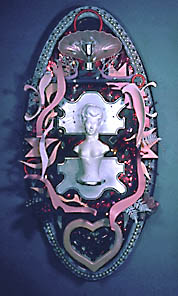

|
Describe the steps involved in creating your works. I play, like a kid with toys till I understand the idea, then I go for the hammer, the scissors, and the brush. Essentially, the plan is to add or subtract until the piece is complicated in meaning and composed for visual harmony. I feel that our culture has many of its operating facts obscured, but by using investigative playing they cannot hide from me. Then I make them ornamental, giving them a tension between seduction and satire. | |

|
Is your composition arranged with aesthetic intent or is it organized for the sake of communication? They are inseparable. I can't move one without the other. For me, beauty is the arm that works the hand of meaning. What qualities attract you to a found object?
Emblems of an ideal are good: A trophy for "best dad". A toy limousine. Plastic Army men. The ceramic head of a Lady that doubles as a plant holder. Things that reveal values of the popular imagination. |
|
Does an object or collection of items suggest a theme or do you begin with an idea and then search for the elements that will communicate that idea?
Well, I do have various cultural obsessions, which naturally guide selection. But I'm also the walking talking Bureau of Symbolism, and if you read everything symbolically, objects are speaking to you loudly all the time. | |

|
How much do you change the found objects from their original state? I do whatever is necessary to suit my theme. This could include leaving something broken, or painting it gold. Do you ever create an object for a piece because the desired object can not be found? Not yet. So far, my point is to reveal the world through it's discarded materials. What are your favorite sources for found objects?
Trash pile, thrift store, yard sale. |
|
What do you find most appealing about working in this medium? It's a fun game of skill and chance. It's my ability to recognize potential combined with the luck of finding things that can become art. Of course I maximize luck by always looking. | |

|
What do you find most challenging? Hunting through other people's rejects can be dirty, dusty work. Also, I live in a not very large house which is completely crammed with stuff, so finding a space to even work is a maximum mental challenge, as if making poetic connections between a thousand objects wasn't hard enough anyway. My studio could be a powerful force for lunacy. I mean, everywhere you look: Doll heads. What is your ultimate goal for the works you create?
To provoke a thrill of recognition. |
|
Do your works share a common theme? My theme is how the pressures of desire, culture and nature work out the fate of the living. My method is archaeological, sifting through discarded layers of material to get an understanding of what kind of society made this stuff, and what do they believe? Describe the statement you are making in "Fiancee with Cow Creamer".
| |
 |
Now get real close to the screen so you can see those tiny details. Wait, when you feel static charges in your face hairs, back up. OK, this piece is about the promises of romance. It's red, based on a box of Valentine's Day chocolates. Moving down from the top, you could read it like a playground chant:
Pearls for Precious/ a mirror for looks/ a cup for the prize of your good intentions/ a pink half-shell for Venus the Armless/ a dark red cow in a heart-shaped stall...It has many details that are hard to see except by standing and looking at it in person, like chess pawns, iridescent glass raspberries with black leaves and plastic wieners, but I hope you get the general idea. |
|
What influences have driven your work? I was cheered on by the use of ordinary things in Pop Art and Folk Art. I was moved by William Gibson's story, Count Zero, in which an artificial intelligence has been programmed to create lyrical boxed assemblages from a family's personal objects. I saw that Joseph Cornell makes debris seem poetic, that Thornton Dial makes debris seem dynamic and the companies who keep raising the cost of traditional art supplies make debris seem affordable. So I go on: gathering trash to conjugate. I live and work by the advice of musician Dolly Parton, who said, "If you can't hide it, decorate it." | |